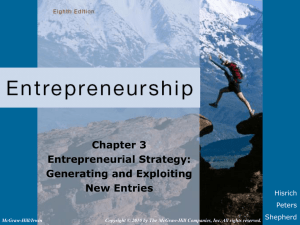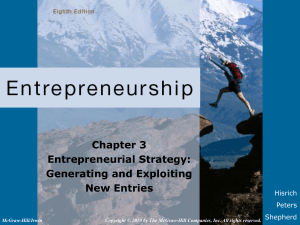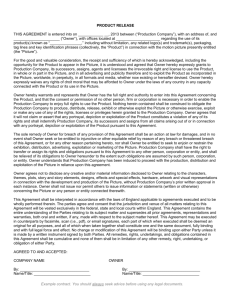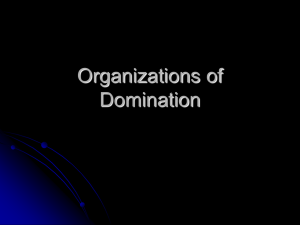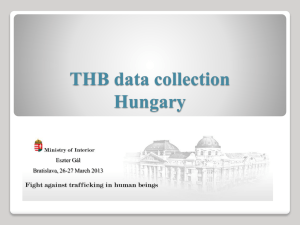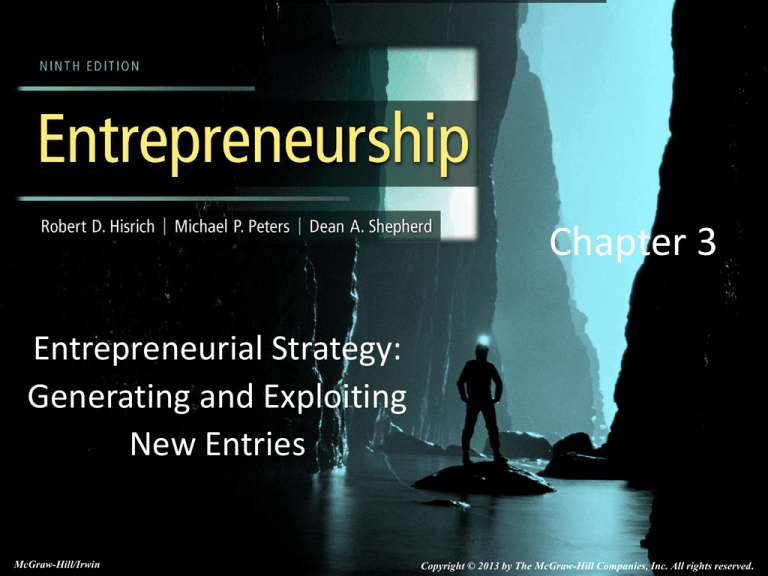
Chapter 3
Entrepreneurial Strategy:
Generating and Exploiting
New Entries
© 2014 by McGraw-Hill Education. This is proprietary material solely for authorized instructor use. Not authorized for sale or distribution in any manner. This document
McGraw-Hill/Irwin
Copyright
© 2013 by The McGraw-Hill Companies, Inc. All rights reserved.
may not be copied, scanned, duplicated, forwarded, distributed, or posted on a website, in whole or
part.
Learning Objectives
• To understand that the essential act of
entrepreneurship involves new entry
• To be able to think about how an
entrepreneurial strategy can first generate,
and then exploit over time, a new entry
• To understand how resources are involved in
the generation of opportunities
• To be able to assess the attractiveness of a
new entry opportunity
3-2
Learning Objectives
• To acknowledge that entrepreneurship
involves making decisions under conditions of
uncertainty
• To be able to assess the extent of first-mover
advantages and weigh them against firstmover disadvantages
• To understand that risk is associated with
newness, but there are strategies that the
entrepreneur can use to reduce risk
3-3
New Entry
• Includes:
• New product in an established or new market
• Established product in a new market
• A new organization
• Entrepreneurial strategy
• Set of decisions, actions, and reactions that
generate, and exploit, a new entry over time
3-4
Figure 3.1 - Entrepreneurial Strategy:
The Generation and Exploitation of New Entry Opportunities
3-5
Generation of a New Entry Opportunity
• Resources
•
•
•
•
•
Inputs into the production process
Source of competitive advantage
Basic building blocks to a firm’s functioning
Can be combined in different ways
Provide capacity to achieve superior performance
when they are:
• Valuable
• Rare
• Inimitable
3-6
Generation of a New Entry Opportunity
• Creating a resource bundle that is valuable,
rare, and inimitable
• Entrepreneurial resource
• Ability to obtain, and recombine, resources into a
bundle that is valuable, rare, and inimitable
• Drawn from the unique experiences and knowledge of
the entrepreneurs
• Market knowledge
• Information, technology, know-how, and skills that
provide insight into a market and its customers
3-7
Generation of a New Entry Opportunity
• Technological knowledge
• Provides insight into ways to create new knowledge
• Assessing the attractiveness of a new entry
opportunity depends on:
• The level of information
• Willingness to make a decision without perfect
information
3-8
Generation of a New Entry Opportunity
• Information on a new entry
• More knowledge ensures:
• Entrepreneur starts from a position of less ignorance
• Less time is spent on information search
• Window of opportunity: Favorable environment
for entrepreneurs to exploit a new entry
3-9
Generation of a New Entry Opportunity
• Comfort with making a decision under
uncertainty
• Likelihood that the window of opportunity will
close leads to the dilemma of choosing between
• Error of commission: Negative outcome from acting on
the perceived opportunity
• Error of omission: Negative outcome from not acting
on the new entry opportunity
3-10
Figure 3.2 - The Decision to Exploit or Not
to Exploit the New Entry Opportunity
3-11
Generation of a New Entry Opportunity
• Decision to exploit or not to exploit the new
entry opportunity
• Assessment of a new entry’s attractiveness
3-12
Figure 3.3- Factors That Influence the Decision
to Enter the Market Now or to Delay Entry
3-13
Entry Strategy for New Entry Exploitation
• Environmental instability and first-mover
(dis)advantages
• Firm performance depends upon the fit between
external environment and resources
• First movers are unaware of key success factors
• Emerging industries
3-14
Entry Strategy for New Entry Exploitation
• Demand uncertainty: Difficulty in estimating:
• Potential size, growth, and the key dimensions along
which a market will grow
• Technological uncertainty: Difficulty in assessing
whether:
• The technology will perform
• Alternate technologies will emerge and leapfrog over
current technologies
• Adaptation
• Persistence and determination can inhibit the ability to
adapt
3-15
Entry Strategy for New Entry Exploitation
• Customers’ uncertainty and first-mover
(dis)advantages
• Uncertainty for customers
• Difficulty in accurately assessing whether the new
product or service provides value
• Overcome customer uncertainty by:
• Informational advertising
• Highlighting product benefits over substitutes
3-16
Entry Strategy for New Entry Exploitation
• Creating a frame of reference for potential customers
• Educating customers through demonstration and
documentation
• Lead time and first-mover (dis)advantages
• Lead time
• Grace period in which the first mover operates in the
industry under conditions of limited competition
3-17
Entry Strategy for New Entry Exploitation
• Lead time can be extended by:
•
•
•
•
Building customer loyalties
Building switching costs
Protecting product uniqueness
Securing access to important sources of supply and
distribution
• Switching costs: Must be borne by customers if
they:
• Stop purchasing from the current supplier
• Begin purchasing from new supplier
3-18
Risk Reduction Strategies for
New Entry Exploitation
• Risk
• Probability, and magnitude, of downside loss
• Derived from uncertainties over:
• Market demand
• Technological development
• Actions of competitors
• Strategies to reduce uncertainties
• Market-scope strategies
• Imitation strategies
3-19
Market Scope Strategies
• Scope: Choice about which customer groups
to serve and how to serve them
• Narrow-scope strategy
• Offers small product range to a small number of
customers to satisfy a particular need
• Focuses on:
•
•
•
•
Producing customized products
Localized business operations
High level craftsmanship
High-end of the market
3-20
Market Scope Strategies
• Broad-scope strategy
• Offers range of products across different market
segments
• Helps gain better understanding of the whole
market
• Opens the firm up to many different “fronts” of
competition
• Reduces risks associated with market
uncertainties
• Increases exposure to competition
3-21
Imitation Strategies
• Copying practices of other
• Advantages
• Help develop skills necessary to be successful in
the industry
• Provide organizational legitimacy
• Reduce costs associated with R&D
• Reduce customer uncertainty over the firm
• Make the new entry look legitimate from day one
3-22
Imitation Strategies
• Types of imitation strategies
• Franchising
• Acquiring a “proven formula” for new entry from a
franchisor
• “Me-too” strategy
• Copying exist products and attempting to build an
advantage through minor variations
3-23
Risk Reduction Strategies for
New Entry Exploitation
• Liabilities of newness
• Negative implications arising from an
organization’s newness
• Arise from:
• Costs in learning new tasks
• Conflict arising from overlap or gaps in responsibilities
• Informal structures of communication
3-24
Risk Reduction Strategies for
New Entry Exploitation
• Assets of newness
• Positive implications arising from an organization’s
newness
• Learning advantage
3-25

